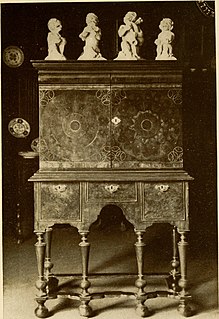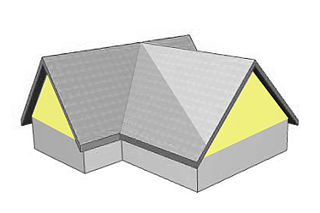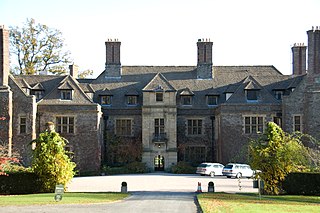Baynham Hall is a Grade II* listed 17th century manor house located in Michaelchurch-On-Arrow, Gladestry, Powys, Wales.

A listed building, or listed structure, is one that has been placed on one of the four statutory lists maintained by Historic England in England, Historic Environment Scotland in Scotland, Cadw in Wales, and the Northern Ireland Environment Agency in Northern Ireland.

A manor house was historically the main residence of the lord of the manor. The house formed the administrative centre of a manor in the European feudal system; within its great hall were held the lord's manorial courts, communal meals with manorial tenants and great banquets. The term is today loosely applied to various country houses, frequently dating from the late medieval era, which formerly housed the gentry.

Gladestry is a small village and community in Radnorshire, Powys, mid Wales, close to the border with England at the end of the Hergest Ridge and south of the large moorland area of Radnor Forest.
Originally built circa 1700, the stone house was added to an earlier wing of the previous property and developments. Of William and Mary-aged proportions across five bays, it has a tall hipped roof, pediment gable containing a Venetian window, and tall chimney stacks. Internally the house contains a period staircase with contemporary turned ballastrades. Adjacent to the main house is an L-shaped 18th century corn barn with byres. [1]

What later came to be known as the William and Mary style is a furniture design common from 1700 to 1725 in the Netherlands, the Kingdom of England, the Kingdom of Scotland, and later, in England's American colonies. It was a transitional style between Mannerist furniture and Queen Anne furniture. Sturdy, emphasizing both straight lines and curves, and featuring elaborate carving and woodturning, the style was one of the first to imitate Asian design elements such as japanning.

A pediment is an architectural element found particularly in classical, neoclassical and baroque architecture, and its derivatives, consisting of a gable, usually of a triangular shape, placed above the horizontal structure of the entablature, typically supported by columns. The tympanum, the triangular area within the pediment, is often decorated with relief sculpture.

A gable is the generally triangular portion of a wall between the edges of intersecting roof pitches. The shape of the gable and how it is detailed depends on the structural system used, which reflects climate, material availability, and aesthetic concerns. A gable wall or gable end more commonly refers to the entire wall, including the gable and the wall below it.
In 1830, Hugh Lloyd, originally of Llanddewi Ystradenny, Radnorshire, purchased Baynham Hall from William Trumper. [2]
Llanddewi Ystradenni is a community in Radnorshire, Powys, Wales. The population of the Community at the 2011 census was 310.

Radnor or Radnorshire is a sparsely populated area, one of thirteen historic and former administrative counties of Wales. It is represented by the Radnorshire area of Powys, which according to the 2011 census, had a population of 25,821. The historic county was bounded to the north by Montgomeryshire and Shropshire, to the east by Herefordshire, to the south by Brecknockshire and to the west by Cardiganshire.
It was Grade II* listed on the 21 September 1962, [3] and forms part of the Cadw registry of ancient Welsh buildings. [4]
Cadw is the historic environment service of the Welsh Government and part of the Tourism and Culture group. Cadw works to protect the historic buildings and structures, the landscapes and heritage sites of Wales, so that the public can visit them, enjoy them and understand their significance. Cadw manages 127 state owned properties and sites. It arranges events at its managed properties, provides lectures and teaching sessions, offers heritage walks and hosts an online shop. Members of the public can become members of Cadw to gain membership privileges.

















